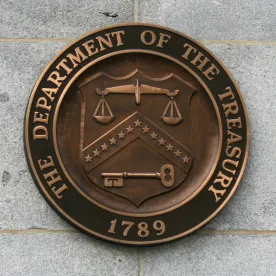I. The Bottom Line
On September 29, 2022, the Financial Crimes Enforcement Network (“FinCEN”) issued final regulations (the “Final Rule”) implementing the comprehensive beneficial ownership reporting requirements of the Corporate Transparency Act (“CTA”)1, a critical part of the Anti-Money Laundering Act of 2020 (the “AMLA”).
The AMLA and CTA provisions are intended to prevent bad actors from using shell companies and complex corporate structures to facilitate and disguise their illicit activity. The Final Rule seeks to achieve the CTA’s goal of addressing weaknesses in the existing patchwork of state laws regarding the collection and maintenance of beneficial ownership information by establishing a clear federal standard for the collection of this information, and by requiring FinCEN to create and maintain a non-public registry to store that information. The Biden Administration has recently emphasized efforts to combat global corruption; that new focus goes hand-in-hand with the US Treasury Department’s acknowledgement for the need to limit the misuse of legal entities by building a beneficial ownership registry, consistent with efforts of the Financial Action Task Force (“FATF”)2 and G7 and G20 leaders to curb the ability of criminal enterprises to hide behind anonymous shell companies.
While the Final Rule tweaked some of the proposed rules outlined in FinCEN’s December 7, 2021 Notice of Proposed Rulemaking (“NPRM”) (such as by extending reporting deadlines and reducing the reporting requirements for “company applicants”), the Final Rule largely retains the overall framework and requirements proposed in the NPRM. Among other provisions, as discussed below in more detail, the Final Rule defines who qualifies as a beneficial owner—those exercising “substantial control” and those with a 25% “ownership interest”—and amends the existing Customer Due Diligence (“CDD”) Rule.
The Final Rule specifies a January 1, 2024, implementation date, but even it notes that it will need to perform substantial implementation work (including a secure database for collecting beneficial ownership information) and that the effective date will depend upon that implementation and Congressional funding. Nonetheless, the Final Rule will have a major impact on businesses and their advisors, so planning for the Final Rule is advisable. FinCEN estimates that once the regulations go into effect on January 1, 2024, tens of millions of existing companies will have to make a report under the CTA3 and approximately two million new entities created each year (and individuals and businesses that routinely facilitate the creation of these entities) will potentially be subject to the regulations. Failure to comply with the new reporting regime could result in civil and criminal penalties.
II. The Backstory
Enacted on January 1, 2021, as part of the AMLA, the CTA introduced sweeping reforms to US anti-money laundering (“AML”) and counter-terrorist financing (“CFT”) laws. The AMLA and CTA were intended to modernize the Bank Secrecy Act (“BSA”), thwart the use of shell companies by criminals, address emerging financial threats, reform whistleblower incentives, and improve coordination and information sharing between regulators, law enforcement, and financial institutions. Before the CTA and the Final Rule, entities were not required to report beneficial ownership information (“BOI”) to federal and state governments. That said, financial institutions are required to collect certain BOI when accounts are opened under existing FinCen regulations.
The CTA and the Final Rule impose reporting requirements4 for BOI and describe who must file a BOI report, what information must be reported, and when such a report is due. FinCEN also notes in the comments to the Final Rule that it has been developing the Beneficial Ownership Secure System (“BOSS”) to receive, store, and maintain BOI.
III. The Full Story
Each state has its own processes and requirements for the formation of corporations and other legal entities. The CTA is intended to close this gap in US anti-money laundering laws by requiring FinCEN to collect the names of beneficial owners at the time of entity formation. Critical to understanding who needs to file—and when—are several key defined terms in the Final Rule, discussed further below.
A. Reporting Companies
The Final Rule takes an expansive view of the CTA’s definition of “reporting companies” that must report information regarding their beneficial ownership to FinCEN. Under the regulations, a “domestic reporting company” is any entity that is created by the filing of a document with a secretary of state or similar office of a jurisdiction within the US.5 A “foreign reporting company” is any entity formed under the law of a foreign jurisdiction that is registered to do business within the US.
B. Exempt Companies
Because the CTA is focused on shell companies and other entities that are lightly regulated and are not required otherwise to report beneficial ownership information, the Final Rule traces the CTA statute and exempts 23 categories of entities from the reporting requirement, including: publicly-traded companies; banks, federal or state credit unions; registered money transmitter businesses; brokers or dealers registered with the Securities & Exchange Commission (“SEC”); insurance companies; investment companies and advisers registered with the SEC; and qualifying larger businesses. FinCen is authorized to expand the list from the statutory list of exempt entities, but it declined to do so.
The Final Rule clarifies the “large operating companies” exemption for entities that have a physical US office; more than 20 “full-time” employees; and which reported more than $5 million in gross receipts or sales on its last US federal tax return. Importantly, the adopting release for the Final Rule notes that companies are not allowed to consolidate headcount across affiliated entities even though the revenue test is on a consolidated basis.6 So, even though wholly-owned subsidiaries of exempt companies would be themselves exempt, the parent cannot count the subsidiary’s employees for the purposes of determining whether it is a large operating company, which could mean that both would end up reporting if the parent itself did not have 20 full-time employees.
C. Beneficial Owner
A “beneficial owner” is defined as someone who directly or indirectly “exercises substantial control over the entity,” or who owns or controls at least twenty-five percent (25%) of the reporting entity’s ownership interests:
i. The “Substantial Control” Prong
The Final Rule requires a reporting company to identify any and all individuals who satisfy the “substantial control” prong. This is more expansive than the existing CDD Rule that requires a covered entity to report only one beneficial owner under the substantial control prong. Moreover, the Final Rule defines three indicators or badges of substantial control: 1) service as a senior officer of a reporting company; 2) authority over the appointment or removal of any senior officer or dominant majority of the board of directors (or similar body) of a reporting company; and 3) direction, determination, decision-making functions, or substantial influence over important matters of a reporting company. Importantly, FinCEN noted that it found the definition of “control” used by the Securities & Exchange Commission to be “too narrowly focused” for purposes of the CTA. In the Final Rule and its comments, FinCEN broadly defines the last prong so that an individual who has “substantial influence” over “important decisions” will be deemed to be a beneficial owner. It provides a non-exhaustive list of the types of “important decisions,” including compensation, approval of equity issuances or operating budgets, changes to governing documents, among others. Control can be found not only through board representation and ownership, but also through, among other things, “rights associated with any financing arrangement or interest.” As the adopting release notes, FinCen is quite aware that this definition will require disclosure of the identities of more individuals than is currently the case under the existing CDD Rule. Notably, under the CDD Rule, only one beneficial owner need be identified under its control test.
ii. The “Ownership” Prong
The Final Rule also expands the “25% of ownership interest” rule beyond that of the CDD rule for financial institutions.
It expansively includes in “ownership interests” not only traditional equity interests, but also profits interests, convertible instruments, options, warrants, and arrangements relating to voting. The Final Rule describes multiple types of ownership interests that vary in terms of ease of definition. At one end of the spectrum, equity and stock interests, capital or profits interest, and proprietorship interests can be, under the right circumstances, straightforward. However, the Final Rule also defines the term “ownership interest” to include a host of future conversions of ownership interests that are not easily defined and will likely depend on retrospective analysis that will provide no comfort when reporting companies are making difficult judgments. The Final Rule also adds a catch-all provision to the definition of ownership to include “[a]ny other instrument, contract, arrangement, understanding, relationship, or other mechanism used to establish ownership.”
We also note that the Final Rule also includes a discussion of how ownership interests should be calculated in determining whether an individual owns or controls—directly or indirectly—25% or more of the ownership interests of a reporting company.
D. Company Applicant
In the case of a domestic reporting company, the “company applicant” is the individual who files the document that forms the entity; for foreign reporting companies, the company applicant is the individual who files the document that registers the entity to do business in the United States.
The Final Rule tracks the CTA’s definition of “company applicant” of a reporting company. The Final Rule, however, does add that in addition to the person filing the entity formation or registration document, a reporting company must also report “any individual who directs or controls the filing of such document by another person.” This requirement is designed to ensure that the reporting company provides information on individuals who are responsible for the decision to form a reporting company. FinCEN believes that this information will be useful to investigate the submission of inaccurate information if it is able to identify both the individual who submitted the report and the person who directed or controlled that activity.
The Final Rule differs from the NPRM, however, in that:
-
domestic reporting companies created prior to the effective date, or foreign reporting companies registered prior to the effective date, are not required to submit company applicant information (rather, they will only need to report their creation or registration and BOI information);
-
“company applicants” are limited to only one or more individuals.
E. What Information Must Be Reported & When Must the Report Be Filed
A reporting company must timely submit a report to FinCEN. The required reports must include each beneficial owner and each company applicant’s full legal name, date of birth, current residential or business address7, and a unique identifier from either an acceptable identification document or a previously-assigned FinCEN identifier. The filing must also contain an image of the identification document.
For reporting companies formed or registered after the effective date, the regulations provide that the initial report must be submitted within 30 calendar days of the date the entity was formed or first registered (this is one change from the NPRM, which initially set a 14-day period for the initial filing). Reporting companies in existence prior to the effective date will have one year (until January 1, 2025) to file their initial reports. The Final Rule also states that if an exempt entity becomes subject to the CTA reporting requirements, it is required to file a report with FinCEN within 30 calendar days after the date on which it no longer meets the exemption criteria (or within the remaining days left in the one-year filing period if it ceases to be exempt during the first year after the effective date, whichever period is longer).
The Final Rule also outlines timeframes for companies that need to file updated and corrected reports. Reporting companies must file updated reports within 30 days “after the date on which there is any change with respect to any information previously submitted to FinCEN.” Unfortunately, this 30-day deadline appears to start on the day the change occurred regardless of whether the reporting company has actual or constructive knowledge of the change.
The Final Rule also extends the 14-day deadline initially proposed in the NPRM for filing corrected reports to now allow 30 days from the date that the reporting company “becomes aware or has reason to know that any required information contained in any report … was inaccurate when filed and remains inaccurate.” FinCEN’s comments to the Final Rule note that the changes to align updated and corrected report deadlines with the initial report deadline of 30 days was intended to “harmonize the reporting timelines, provide substantial time to obtain required information, and minimize potential confusion.”
IV. Odds and Ends
Notably, given the sensitivity of the reportable information, the BOSS beneficial ownership registry will not be public. The law authorizes FinCEN to disclose the beneficial ownership information it collects for only two purposes: 1) to facilitate important national security, intelligence, and law enforcement activities, and 2) to confirm beneficial ownership information provided to financial institutions to facilitate their compliance with applicable anti-money laundering and customer due diligence requirements. FinCEN may also disclose beneficial ownership information to financial institutions to facilitate compliance with the CDD Rule so long as it has the reporting company’s consent.
The CTA provides that any willful violation of beneficial ownership reporting requirements can lead to penalties, including (1) civil penalties of up to $500 per day that a violation has not been remedied; and (2) criminal penalties of up to $10,000 and imprisonment of up to two years. The Final Rule adopts this penalty framework, clarifying that liability can be for direct or indirect violations, and for acts (i.e., reporting of inaccurate information) or omissions (i.e., failure to provide or update any required information). Accordingly, any person who willfully fails to file complete beneficial ownership information, who files false or fraudulent information, or who knowingly makes an unauthorized disclosure or use of beneficial ownership information obtained from FinCEN is subject to civil and criminal liability.
In addition to the CTA and its beneficial ownership disclosure requirements, the AMLA also provides for expanded whistleblower incentives and protections, additional (and stronger) BSA violations and penalties, and expanded subpoena power for the government, along with numerous other changes that will warrant watching as they are implemented.
Elizabeth P. White also contributed to this article.
FOOTNOTES
1 The CTA is found at 31 U.S.C. § 5336; the Final Rule will be at 31 CFR § 1010.380 once effective.
2 Notably, FATF has specifically identified the United States’ lack of beneficial ownership reporting requirements as a critical shortcoming of the US AML regime.
3 Entities formed or registered before the effective date have one year to file reports.
4 The Final Rule is the first of three required rulemakings related to the CTA. FinCEN will ultimately issue two additional rulemakings for the purposes of: 1) creating a secure central database and establishing the rules for which individuals and entities may access BOI, for what purposes, and what safeguards will be required to protect this information; and 2) revising and conforming FinCEN’s existing Customer Due Diligence Rule for financial institutions.
5 Accordingly, as the adopting release relating to the Final Rule notes, sole proprietorships, trusts and general partnerships would not usually be reporting companies, since a filing is not required to create them.
6 87 FR 59498, 59543 (“FinCEN declines to permit companies to consolidate employee headcount across affiliated entities. Although the CTA specifies that gross receipts or sales are to be consolidated, the CTA contains no similar specification for employee headcount.”)
7 The Final Rule clarifies that company applicants that provide a business service as a corporate or formation agent may report their business address rather than a residential address.








 />i
/>i

